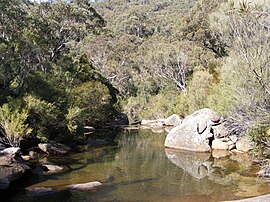Heathcote National Park
| Heathcote National Park New South Wales | |
|---|---|
 A view of Heathcote Creek, looking North. | |
| Nearest town or city | Sydney |
| Coordinates | 34°07′49″S 150°58′17″E / 34.13028°S 150.97139°E |
| Established | January 1943[1] |
| Area | 26.79 km2 (10.3 sq mi)[1] |
| Managing authorities | NSW National Parks & Wildlife Service |
| Website | Heathcote National Park |
| See also | Protected areas of New South Wales |
Heathcote National Park is a
Geography
The park consists of 2,679 hectares of woodland, predominantly dry schlerophyll forest on the ridges and low heath in the wetter areas. The Hawkesbury sandstone has been carved up by various watercourses like Heathcote Creek, Kingfisher Creek and Myuna Creek, creating deep valleys. The Hawkesbury sandstone has created a sandy, infertile soil that is typical of the Sydney region.
The main walking track is the Bullawarring Track, which stretches from Waterfall to Heathcote. It largely follows the valley of Heathcote Creek, the main watercourse in the park, as well as utilizing a maintenance road that leads from Woronora Dam to Heathcote Road.
It is bounded by
.History


Before European settlement, the
In the early 1930s, The Sydney Bushwalkers and the Mountain Trails Club of New South Wales had a lease on 75 hectares (190 acres) of land in the area, and were probably responsible for the creation of some of the early tracks and camp sites. This was the beginning of Heathcote National Park, which eventually grew to over two thousand hectares.[3]
Features
Landscape
The park consists of a deeply dissected Hawkesbury sandstone plateau, part of the Woronora Plateau The creek gorges include Heathcote Creek, a tributary of the Georges River. The sandstone was formed 200 million years ago, and periods of uplift began about 94 million years ago. Each period of uplift caused stream erosion, which cut more deeply into the plateau surface. Heathcote Creek cascades down a number of rock pools and small waterfalls to the Woronora River at the northern end of the park.
Flora

The ridges and drier slopes are covered in forest dominated by
Fauna
Fish, eels and crayfish are commonly found in the creeks.See also
References
- ^ a b "Heathcote National Park: Park management". Office of Environment & Heritage. Government of New South Wales. Retrieved 10 October 2014.
- ^ Paton, Neil (2004). Sydney and Blue Mountains Bushwalks. Kangaroo Press. pp. 132, 137–139.
- ^ Map of Royal NP, Heathcote NP and Garrawarra State Recreation Area (Department of Lands) Fourth Edition
- ^ a b "Heathcote National Park - Natural environment". Archived from the original on 9 September 2007.
External links
- "Heathcote National Park". NSW National Parks & Wildlife Service. Government of New South Wales.
- Heathcote National Park (PDF Map). NSW National Parks & Wildlife Service, Government of New South Wales.
- "Royal National Park, Heathcote National Park and Garawarra State Recreation Area: Plan of management" (PDF). ISBN 0-7310-0895-2.
- "Amendments to the Royal National Park, Heathcote National Park and Garawarra State Recreation Area: Plan of management 2000" (PDF). ISBN 978-1-74232-956-7.
- "Heathcote National Park". Office of Environment & Heritage. Government of New South Wales.
- "List of fauna". Wildlife Atlas. Archived from the original on 15 June 2005.
- List of animals recorded in the park

